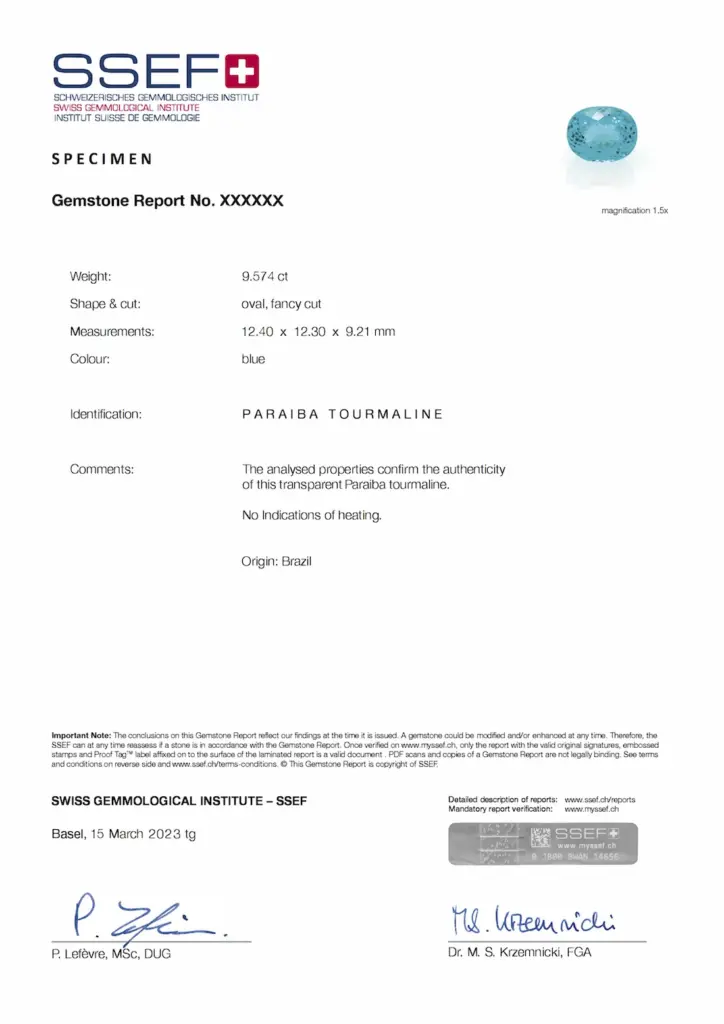Paraiba tourmaline
A Paraiba tourmaline is a blue, bluish green to greenish blue or green tourmaline, of medium-light to high saturation and tone (relative to this variety of tourmaline), mainly due to the presence of copper (Cu) and manganese (Mn). The name of the tourmaline variety ‘Paraiba’ is derived from the Brazilian locality where this gemstone was first mined, but other sources such as Nigeria and especially Mozambique are known today.

Report No & Photo
The SSEF report number is the number given to the item when it is submitted for testing, and is a unique number. If an item is resubmitted later for a ‚recheck‘ after re-cutting or for a report update then the item obtains a new report number.
The photo of a Paraiba tourmaline depicts the gem at the time of testing. The photo on an SSEF report is for representational purposes and does not necessarily represent actual colour, clarity or size. For size comparison purposes, approx. magnification used is provided under the photo on the report.
Weight
Weight of a Paraiba tourmaline in carats, measured and stated with 3 digits. In the case of mounted jewellery, total weight corresponds to total weight of jewellery item(s) and is stated in grams.
Shape & Cut
The shape and cut describe the outlining shape and cutting style of an examined gemstone. For jewellery items with several stones, a range of shapes and cuts may be stated, if these vary.
Measurements
The measurements are given at 2 decimal places. They generally represent length x width x height of a gemstone. For series of gemstones or gemstones in jewellery, a range of measurements may be stated on the report.
Colour
The colour of Paraiba tourmaline is described using descriptive terms such as blue, light blue, greenish blue, green. No trade terms (e.g. electric blue, neon blue) are used by SSEF on reports.
Identification
If a Paraiba tourmaline is found to be of Brazilian origin, it would be identified as a ‘Paraiba tourmaline‘ in the Identification section of the report. If it is from another origin (e.g. Mozambique, Nigeria) but fits colour and chemical criteria for paraiba tourmalines it would be identified as a ‘Tourmaline‘ with an added comment in the comments section:
- This copper- and manganese-bearing tourmaline may also be called ‘Paraiba tourmaline in the trade.
Treatment
Paraiba tourmalines are commonly heat treated. If a Paraiba tourmaline is not heat treated (and this can be confirmed gemmologically), the comments section would mention: “no indications of heating”.
If the stone shows indications of heat treatment, the report would mention: “indications of heating”.
In cases where a treatment cannot be conclusively detected, the following would be stated on the report: “The colour of ‘Paraiba tourmaline’ may be improved or changed by a heat treatment. It is currently not possible to determine if the described ‘Paraiba tourmaline’ has been heated or not. The colour is however considered stable.”
In case a fissure filler (e.g. oil or artificial resin) is detected this would be mentioned in the comments section of the report and would be quantified (minor, moderate, significant). If an insignificant amount of filler (e.g. oil, artificial resin) is present in a stone, this is not mentioned on an SSEF report. This is in line with international LMHC guidelines.
Origin
Origin determination is an expert opinion. At SSEF origin determination relies on the analysis of microscopic features, trace element concentrations, and spectroscopic data of a coloured gemstone. The measured data pertaining to a specific client stone is then compared with our extensive reference collection and database of coloured gemstones of known origin, and scientific gemmological literature.
Report date & verification
The date corresponds to the date on which gemmological testing of the item was concluded. SSEF reports can be verified on www.myssef.ch